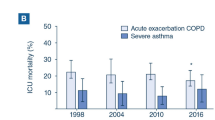Abstract
Objective
To compare the efficacy of all types of spacers commonly available to children in India.
Methods
150 children 5–14 yr of age with persistent asthma presenting with peak expiratory flow (PEF) <70% of personal best were randomized to receive 200μg salbutamol through one of five spacers: A) 750ml spacer with valve, B) 165ml spacer with valve, C) 250ml spacer without valve, D) 1000ml indigenously made spacer without valve and E) 500ml indigenously made spacer without valve. PEF measurement was repeated 15 minutes later. Children >8 yr old performed spirometry in addition to PEF. Absolute change and percentage improvement of PEF and FEV1 were compared among the groups.
Results
Subjects in all groups had comparable baseline demographic characteristics and PEF. All showed significant improvement in PEF and FEV1 over baseline values. The change in PEF and percentage improvement were comparable among all five groups (p=0.780 and p=0.955 respectively). Likewise change in FEV1 and percentage improvement were also comparable. The five groups showed no difference in efficacy, irrespective of severity of baseline airway obstruction.
Conclusion
The five spacers were equally efficacious for the delivery of bronchodilator in children with moderate persistent asthma presenting with airway obstruction.
Similar content being viewed by others
References
Cates CJ, Bara A, Crilly JA, Rowe BH. Holding chambers versus nebulisers for beta-agonist treatment of acute asthma. The Cochrane Database of Systematic Reviews 2003; Issue 2. Art. No.: CD000052. DOI: 10.1002/14651858.CD000052.
Buxton LJ, Baldwin JH, Berry JA, Mandleco BL. The efficacy of metered-dose inhalers with a spacer device in the pediatric setting. J Am Acad Nurse Pract 2002; 14: 390–397.
Castro-Rodriguez JA, Rodrigo GJ. Beta-agonists through metered-dose inhaler with valved holding chamber versus nebulizer for acute exacerbation of wheezing or asthma in children under 5 years of age: a systematic review with meta-analysis. J Pediatr 2004; 145: 172–177.
Zar HJ, Liebenberg M, Weinberg EG, Binns HJ, Mann MD. The efficacy of alternative spacer devices for delivery of aerosol therapy to children with asthma. Ann Trop Paediatr 1998; 18: 75–79.
Zar HJ, Brown G, Donson H, Braithwaite N, Mann MD, Weinberg BG. Home made spacers for bronchodilator therapy in children with acute asthma: A randomized trial. Lancet 1999; 354: 979–982.
Zar HJ, Weinberg EG, Binns HJ, Gallie F, Mann MD. Lung deposition of aerosol-a comparison of different spacers. Arch Dis Child 2000; 82: 495–498.
Willemse BW, Toelle BG, Li JS, Shah S, Peat JK. Use of a paper disposable cup as a spacer is effective for the first-aid management of asthma. Respir Med 2003; 97: 86–89.
WHO Programme for the control of Acute Respiratory infections. Bronchodilators and other medications for the treatment of wheeze-associated illness in young children. Geneva: WHO 1993; 14–17.
Global Initiative for asthma. Global strategy for asthma management and prevention. A practical guide for public health officials and health care professionals. NHLBI/WHO Workshop Report 1995; 23.
O’Callaghan C, Lynch J, Cant M, Robertson C. Improvement in sodium cromoglycate delivery from a spacer device by use of an antistatic lining, immediate inhalation and avoiding multiple actuations of drug. Thorax 1993; 48: 603–606.
Dolowich M. Physical principles underlying aerosol therapy. J Aerosol Med 1989; 2: 171.
Parmar V, Kumar L, Malik SK. Normal values of peak expiratory flow rates in healthy North Indian school children 6–16 years of age. Ind Pediatr 1977; 14: 591–594.
American Thoracic Society. Standardization of spirometry recommendations. 1994 update. Am J Respir Crit Care Med 1995; 152: 1107–1136.
Singhal T, Garg H, Arora HS, Lodha R, Pandey RM, Kabra SK. Efficacy of a home-made spacer with acute exacerbation of bronchial asthma: a randomized controlled trial. Indian J Pediatr 2000; 68(1): 37–40.
Rajkumar, Vatsa HK, Gaur SN. Comparative evaluation of market spacer and home made spacer in the management of bronchial asthma. J Assoc Physicians India 2002; 50: 397–399.
Zar HJ, Asmus MJ, Weinberg EG. A 500-ml plastic bottle: an effective spacer for children with asthma. Pediatr Allerg Immunol 2002; 13: 217–222.
Rodriguez C, Sossa M. Commercial versus home-made spacers in delivering bronchodilator therapy for acute therapy in children. Protocol) The Cochrane Database of Systematic Reviews 2005, Issue 4. Art. No.: CD005536. DOI: 10.1002/14651858.CD005536
Corr D, Dolovich M, McCormack D. Design and characteristics of a portable breath actuated, particle size selective medical aerosol inhaler. J Aerosol Sci 1982; 13: 1–7.
Barry PW, O’Callaghan C. The effect of delay, multiple actuations and spacer static charge on the in vitro delivery of budesonide from the Nebuhaler. Br J Clin Pharmacol 1995; 40: 76–78.
Fok TF, Lam K, Chan CK. Aerosol delivery to non-ventilated infants by metered dose inhaler: should a valved spacer be used? Pediatr Pulmonol 1997; 24: 204–212.
Newman SP, Moren F, Pavia D. Deposition of pressurized suspension aerosols inhaled through extension devices. Am Rev Respir Dis 1981; 124: 317–320.
Author information
Authors and Affiliations
Corresponding author
Rights and permissions
About this article
Cite this article
Dahiya, B., Mathew, J.L. & Singh, M. Randomized trial of spacers in asthma. Indian J Pediatr 74, 631–635 (2007). https://doi.org/10.1007/s12098-007-0112-0
Received:
Accepted:
Published:
Issue Date:
DOI: https://doi.org/10.1007/s12098-007-0112-0




